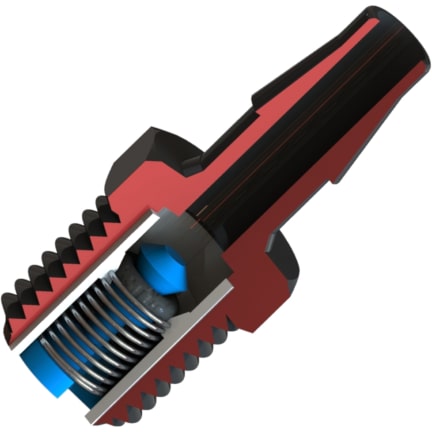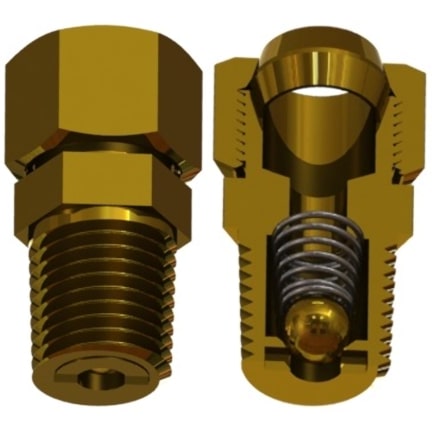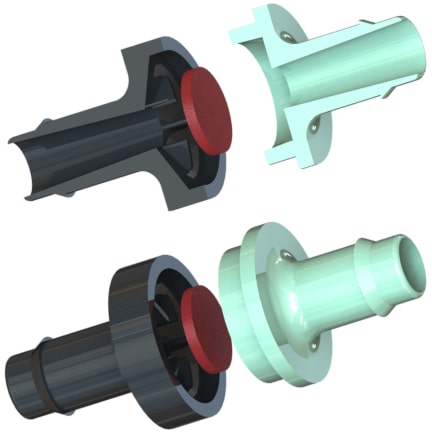10 Tips for Selecting a Miniature Check Valve
Introduction

This post is about inline direct-acting miniature check valves. These are not pilot-operated valves. Instead, they use a simple flexing or moving part, the sealing element, to prevent backflow. The force of the media (gas or liquid) flowing in the system pushes against the sealing element to open the valve (downstream flow) or close the valve (upstream flow) with or without the aid of an internal spring.
Miniature check valve applications
General miniature check valve applications:
- Prevent accidental spills or atmospheric releases
- Protect purified flow from backflow contamination
- Protect sensitive equipment from backflow damage or contamination
- Prevent crossover flow between systems with unequal line pressures
- Allow complex systems to work correctly by guaranteeing one-way flow
- Maintain pump priming by holding liquid within a system or pipe after a pump has shut off
1. Choosing a Cracking Pressure
Choose a check valve cracking pressure that is close to but below the full flow pressure of the system design. Full flow pressure is the pressure created by normal operating conditions, and it should be higher than the cracking pressure. This choice of cracking pressure ensures that the check valve fully opens and provides maximum flow through the valve when needed.
Check valves with flexing rubber sealing elements
Unlike free-floating diaphragm check valves, flexing diaphragm check valves require a higher positive downstream pressure across the valve to open and provide flow. Flexing diaphragm, duckbill, and umbrella check valves use the physical properties of elastomers (rubbers) and the valve's design to create resistance to downstream flow through the check valve.
Engineering this cracking pressure involves choosing the elasticity of the elastomer or rubber, the amount of squeeze applied when assembled (seal preload), and the rubber's thickness in the section of the valve that flexes.
The particular case of duckbill check valves
Low pressure, low flow applications such as medical tubing sets use miniature duckbill check valves. This choice is because duckbills are extremely sensitive to pressure or flow fluctuations, and they:
- Seal around trapped solids
- Have very low resistance to flow
- Have very low cracking pressures
- Provide tight reseal at low flow rates and low differential pressures
Check valve cracking pressure, especially for the range of applications that use different miniature check valve designs and materials, is a relatively complex subject. Find out more details about check valve cracking pressures and how they relate to check valve design.
2. Maximum Working Pressure
Maximum working and backflow pressures
Both internal media pressures and external environmental pressures affect check valve performance. Be sure the manufacturer's recommended operating pressure range, maximum backflow pressure, and burst pressure work for the application.
Maximum operating pressure is the maximum internal pressure a check valve is exposed to during normal operating conditions.
It is also essential to know the maximum backflow pressure expected in the application. The internal mechanism of a check valve will have limits to the amount of backpressure it can handle without damaging internal parts.
A check valve's burst pressure will be higher than both its maximum backflow and operating pressures.
3. Maximum and Minimum Operating Temperatures
Media temperatures and environmental temperatures affect check valve performance. Choose a check valve with a known working temperature range appropriate for your application because the valve likely contains internal components made of different materials than the valve body.
Just because a check valve is metal doesn't mean temperature won't be an issue. Many metal check valves use rubber seals. Also, all polymers have significantly higher thermal expansion coefficients than metals.
4. Reseal Pressure
Reseal pressure, spring-loaded check valves and bubble-tight seals
Spring-loaded check valves are used because they can provide a positive seal. In most cases, spring-loaded valves will reseal at pressures below the cracking pressure. But if you need a check valve that reseals with no detectable backflow, be sure the cracking pressure and system backflow pressure together are enough to create a bubble-tight seal.
Low-pressure applications and reseal pressure
Generally, spring-loaded check valve reseal pressures tend to be about 20% lower than their cracking pressure.
Spring-loaded check valves with cracking pressures lower than 3 to 5 PSIG will likely require additional backpressure to create bubble-tight seals. For example, a 1/3 PSI cracking pressure check valve may need as much as 20 PSI backpressure to create a bubble-tight seal.
If your low-pressure application cannot tolerate any backflow and requires a bubble-tight reseal, consider putting two spring-loaded check valves in series. These are usually called dual or double check valve backflow preventers.
Adding a second check valve in line with the first changes the working interaction of the valves to provide a reseal pressure that is essentially 0 (zero) PSI across the valves.

Two spring-loaded plastic check valves in series
5. Body and Seal Materials
Check valve components
Check valves include multiple components possibly made of a variety of materials. Please make sure all check valve components are compatible with the fluids or gases flowing through them.
Check valve components may include some or all of these:
- Seal
- Body
- Spring
- Valve seat
- Connections
- Sealing element

Metal versus plastic check valve bodies
Metal check valves
- Higher burst pressures
- Lower thermal expansion
- Greater stress resistance
- Better shock pressure resistance
- Able to handle higher temperatures
- Plastic check valves
- Lower cost
- Lighter weight
- Longer service life
- Less prone to leaking
- Better corrosion resistance
- Better resistance to cavitation
- Broader chemical compatibility
6. Flow Capacity and Efficiency
Check valves flow capacity
Flow capacity is the flow volume that can pass through a check valve at a minimum pressure high enough to open the valve fully. Manufacturers usually provide the flow capacity of their check valves.
Oversized check valves have a flow capacity that is too high for much of a system's normal operating pressure range and will not fully open. This oversizing creates unnecessary pressure loss across the valve. The resulting flow will also be more turbulent, which causes premature wear to the valve's internal parts and reduce its working life.
Undersized check valves create unnecessary flow restriction and pressure loss across the valve. This undersizing reduces system efficiency. A simple guideline for estimating check valve size is to choose a valve that provides the system's maximum required flow rate when the valve is between 20% and 80% open.
Check valve flow efficiency
The interior flow path and the smoothness of the surfaces exposed to the media flow affect flow efficiency. Internal valve flow paths through check valves can be optimized for improved flow efficiency. Generally, the inner walls of plastic check valves tend to be smoother and offer less resistance to flow than metal check valves.
If the flow coefficient (Ck or Kv) is available for a comparable check valve, choose the valve with the highest number, the highest flow coefficient. The valve with the highest flow coefficient will have a lower pressure drop across the valve.
If practical, use flow calculations to size your check valve properly. Keep in mind that modeling flow can be complex. It may be necessary to test one or more selected check valves to optimize system performance. You can request check valve samples from ISM by using the “Request Sample” tab of the valve’s landing page on our website.
7. End Connection Types
The most common miniature check valve connection types
- Push-in
- Threaded
- Hose barb
- Luer taper
- Compression
Many miniature check valve series are available in mix-and-match connector type combinations such as hose barb by thread, compression by hose barb, and so on. Check valve customization can ensure getting the connections you need.
Threaded connections
NPT (National Pipe Tapered) thread and UNF (United Fine Thread) threaded connections are the most common. These are usually offered in all three flavors: male by male, female by female and male by female, including male by female downstream and female by male downstream.
UNF are parallel or straight threads and require rubber gaskets, O-rings, or bonded seal washers to create leak-tight seals. Many check valve series are available with UNF thread options because some applications and industry standards require tight, fine threads.
Accurately determine the thread type needed. Threaded connections need to match for both mechanical strength and leak-tight seals.
8. Check Valve Orientation
Spring loaded check valves
Because spring force and not gravity closes these check valves, they can be used for horizontal and vertical installations. In vertical installations, the weight of the fluid above the valve should factor into calculations for choosing cracking pressure.
For upward flow installations, the force of the fluid's weight works in combination with the sealing force of the spring. In downward flow installations, the force of the fluid's weight works in opposition to the sealing force of the spring.
No-spring check valves
No-spring check valves with poppet, ball, piston, and similar sealing elements are generally intended for horizontal installation. They can also be used in vertical installations with upward flow if the force of gravity on the sealing element is enough to create the appropriate seal. This seal will most likely not be bubble tight. In liquid handling applications, keep in mind that the fluid's weight in the vertical run above the valve will add additional force holding the check valve closed. In low-pressure applications, fluid density and viscosity also affect cracking pressure and reseal quality.

Plastic diaphragm check valves Low-pressure plastic diaphragm check valves usually function correctly in any orientation in vacuum applications and when handling gases. Keep in mind, installing these check valves in long vertical fluid-carrying runs should probably be for upward flow only. The force of the fluid's weight acts to hold the check valve closed. A viscous or dense liquid tends to increase the cracking pressure of the valve and reduce its ability to reseal when there is backflow.
9. Maintenance
Miniature check valves and installation clearance
Give some consideration to the possible maintenance challenges to replacing or repairing miniature check valves. These check valves are often installed in applications where space limitations can make them difficult to service. When valve design allows for miniature check valve repair, repair requires removing it from the flow line. Fortunately, when properly chosen and installed, direct-acting check valves are notably durable and maintenance-free.
10. Flow Direction
Flow direction and valve markings
Proper check valve function always requires installation with the correct orientation to flow. Be sure you know the flow direction in the system before installing the check valve. Most check valves come with flow direction indicated by an arrow or similar marking on the valve body.
Customized check valves tend not to have flow direction indicated on the valve bodies. Instead, rely on paperwork or attached tags that come with the valves. Packing lists and invoices should include a clear indication of these valves' flow direction.
Conclusion
These ten tips for choosing a check valve should make finding the suitable miniature check valve for your application easier. Keep in mind that good customer support includes before-sale consultation and support. Sales representatives have a wealth of experience to draw on. This hands-on knowledge and other resources like material chemical compatibility guides should make even the most challenging application requirements easier to solve.
« Go back to the blog homepage
